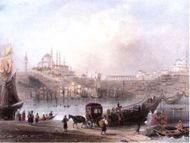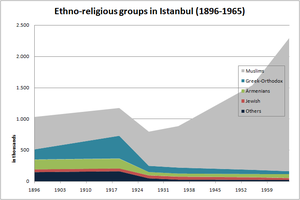تاريخ اسطنبول
تاريخ اسطنبول يشرح التطورات التاريخية لمدينة اسطنبول الحالية.
. . . . . . . . . . . . . . . . . . . . . . . . . . . . . . . . . . . . . . . . . . . . . . . . . . . . . . . . . . . . . . . . . . . . . . . . . . . . . . . . . . . . . . . . . . . . . . . . . . . . . . . . . . . . . . . . . . . . . . . . . . . . . . . . . . . . . . . . . . . . . . . . . . . . . . . . . . . . . . . . . . . . . . . .
قبل التاريخ
عاش البشر في المنطقة المسماة اليوم اسطنبول منذ العصر الحجري الحديث على الأقل. أول استيطان معروف يعود إلى 6700 ق.م.، واِكتُشِف في 2008 في كهف يريمبورگاز (Yarımburgaz)، بالقرب من بحيرة كچكچكمجى (Küçükçekmece)، أثناء أعمال إنشاء محطة مترو ينيكاپي و نفق مرمراي في شبه الجزيرة التاريخية على الجانب الأوروپي.[1][2][3] أول مستوطنة بشرية على الجانب الأناضولي، فقيرتپه Fikirtepe، تعود إلى العصر النحاسي، بلقى تتراوح فترتها من 5500 حتى 3500 ق.م.[4] وفي قاضيكوي (خلقدون) القريبة، اِكتـُشِف مستوطنة ميناء فينيقي.
ليگوس
 مقالة مفصلة: ليگوس
مقالة مفصلة: ليگوس
أقدم اسم معروف للمدينة كان ليگوس[5] حسب پلني الأكبر أحداثه التاريخية. وقد أسستها القبائل التراقية بين القرنين 13 و 11 ق.م.، بجانب قرية الصيادين المجاورة سميسترا.[6][المصدر لا يؤكد ذلك] فقط بضعة أسوار ومنشآت جزئية تعود إلى ليگوس قد بقيت حتى يومنا هذا، بالقرب من نقطة سيراليو (تركية: Sarayburnu)،[7] حيث يوجد اليوم قصر طوپ كاپي الشهير. ليگوس وسميسترا كانتا المستوطنتين الوحيدتين على الجانب الأوروپي من القسطنطينية. وعلى الجانب الآسيوي كانت توجد مستعمرة فينيقية. وفي موقع ليگوس، قامت بيزنطيوم لاحقاً. ولذلك يتفق المؤرخون على أن ليگوس هي المدينة التي تطورت لتصبح القسطنطينية.
الفترة الرومانية المتأخرة والامبراطورية الرومانية الشرقية (البيزنطية)
الدولة العثمانية
الفتح
 مقالة مفصلة: فتح القسطنطينية
مقالة مفصلة: فتح القسطنطينية

العاصمة الامبراطورية

الأوقاف

العصرنة
- Street in Eyüp.jpg
A street in Eyüp in 1890s
جمهورية تركيا
When the جمهورية تركيا أسسها مصطفى كمال أتاتورك في 29 October 1923, the capital was moved from اسطنبول إلى أنقرة.
. . . . . . . . . . . . . . . . . . . . . . . . . . . . . . . . . . . . . . . . . . . . . . . . . . . . . . . . . . . . . . . . . . . . . . . . . . . . . . . . . . . . . . . . . . . . . . . . . . . . . . . . . . . . . . . . . . . . . . . . . . . . . . . . . . . . . . . . . . . . . . . . . . . . . . . . . . . . . . . . . . . . . . . .
الهامش
- ^ BBC: "Istanbul's ancient past unearthed" Published on 10 January 2007. Retrieved on 3 March 2010.
- ^ Hürriyet: Bu keşif tarihi değiştirir (2 October 2008)
- ^ Hürriyet: صور من موقع العصر الحجري الحديث، حوالي 6500 ق.م.
- ^ "Cultural Details of Istanbul". Republic of Turkey, Minister of Culture and Tourism. Retrieved 2007-10-02.
- ^ پلني الأكبر، المجلد الرابع، الفصل الحادي عشر:
"ولدى مغادرتنا الدردنيل أتينا إلى خليج كاستينس Casthenes, ... and the promontory of the Golden Horn, on which is the town of Byzantium, a free state, formerly called Lygos; it is 711 ميل من دوراتزو، ..." Archived 1 يناير 2017 at the Wayback Machine - ^ Vailhé, S. (1908). "Constantinople". Catholic Encyclopedia. Vol. 4. New York: Robert Appleton Company. Retrieved 2007-09-12.
- ^ خطأ استشهاد: وسم
<ref>غير صحيح؛ لا نص تم توفيره للمراجع المسماةjanin - ^ Byzantium 1200: Monastery of Saint George of the Mangana







